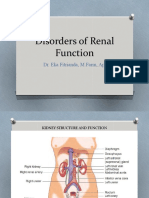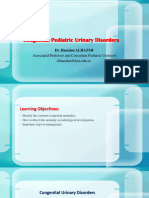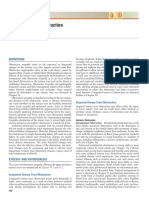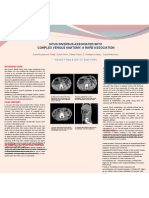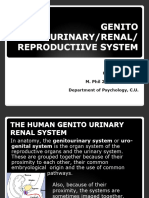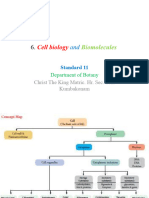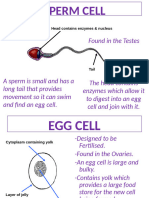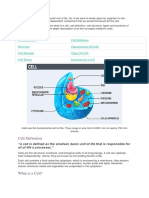Congenital Anomalies of Kidney and Lowe Urinary Tract
Congenital Anomalies of Kidney and Lowe Urinary Tract
Uploaded by
LanaAmerieCopyright:
Available Formats
Congenital Anomalies of Kidney and Lowe Urinary Tract
Congenital Anomalies of Kidney and Lowe Urinary Tract
Uploaded by
LanaAmerieOriginal Description:
Original Title
Copyright
Available Formats
Share this document
Did you find this document useful?
Is this content inappropriate?
Copyright:
Available Formats
Congenital Anomalies of Kidney and Lowe Urinary Tract
Congenital Anomalies of Kidney and Lowe Urinary Tract
Uploaded by
LanaAmerieCopyright:
Available Formats
Congenital Anomalies of Kidney and Lowe Urinary Tract
Congenital Anomalies of kidney Congenital Anomalies of Ureters Congenital Anomalies of the Bladder Congenital Anomalies of the penis
Agenesis of Kidney Hypoplasia Ectopic Kidneys Horseshoes kidneys Double & Bifid Ureters Ureteropelvic Junction obstruction Diverticula Vesicuretral reflux Diverticula of the bladder Exstrophy of Bladder Urachal anomalies Hypospadias
Clinical Bilateral:
- Bilateral→renal failure - Predisposes it to bacterial - 1 in 500 to 1000 autopsies
- most unilateral; no clinical significance - congenital disorder that commonly - uncommon lesions
- most common
- Predispose infection and formation of - risk for infections that spread to - carcinoma
Hypospadias:
Presentation - incompatible with life
in childhood
infection bc of abnormal causes hydronephrosis in Infants and - Congenital or acquired
- Serious congenital anomaly of bladder calculi (from urinary stasis) upper levels dues to exposed - more common
- encountered in stillborn infants
- Unilateral common
position, kinking or tortuosity children
- Most asymptomatic but bladder
bladder
- 1 in 300 live male births
- associated w. limb defect and - True renal hypoplasia of ureters that causes - 20% bilateral UPJ present early
urinary stasis within - Ascending Urinary Tract Infection - ↑ risk for adenocarcinoma - Even when isolated, these urethral
Hypoplastic lungs
observed in Low Birth obstruction to urinary flow
- Preferentially in males
diverticula→recurrent (result of vesicoureteral orifice → arising in remnant bladder
defects have clinical significance bc
infants
- bilateral associated with other congenital infection vesicoureteral reflux)
- Lesions may be surgically the abnormal opening is often
Unilateral agenesis:
- Increased lifetime risk anomalies - Chronic reflux-associated corrected
constricted resulting in urinary
- uncommon
for CKD pyelonephritis (CRAP): common - Long term survival is possible tract obstruction and increased risk
- Unilateral: compatible with life if cause of chronic pyelonephritis of ascending UTI
no other abnormalities exist - When orfices are near base of
penis, normal ejaculation and
insemination are hampered and may
cause sterility
Pathogenesis - CRAP: results from - exposed bladder mucosa can Urachal cysts →glandular - associated with failure of normal
superimposition of UTI on - most small and asymptomatic
undergo colonic glandular tumors or carcinomas
descent of testes with
congenital vesicoureteral reflux and - can be clinically significant: cause sites metaplasia - minority of bladder cancers malformations of urinary tract
intrarenal reflux
w. urinary stasis
(0.1-0.3%)
- Bilateral → chronic renal - 20-40% badder
insufficiency adenocarcinoma
Structural Unilateral agenesis: in solitary - kidney fail to develop - development of metanephros - fusion of upper (10%) or - associated with distinct double renal - saccular outpouchings of - Reflux and associated renal - congenital diverticula: due to focal - development failure in anterior - urachus patent in part of in - malformation of urethral groove canal
Morphology kidney
to normal size into kidney occurs in ectopic lower poles (90%) of kidneys pelves or with anomalous ureteral wall
damage: unilateral or bilateral failure of development of normal wall abdomen and bladder
whole
creating abnormal urethral opening
- enlarges and hypertrophy to foci
produce a horseshoe-shaped development of a large kidney having - Dilation (hydroureter), musculature OR some urinary tract - bladder communicates directly - Normally: urachus (canal either on ventral surface of the penis
compensate
- lie either just above pelvic that is continuous across the a partially bifid pelvis terminating in elongation, tortuousity of obstruction during fetal development
thru a large defect with surface that connects the fetal (Hypospadias) or dorsal surface
- Can develop glomerular sclerosis brim or sometimes within midline anterior to great separate ureter
ureter - Can be acquired
of body or lies as an opened bladder with allantois) is (Epispadia)
due to adaptive changes in pelvis
vessels - pouchlike evaginations of bladder wall
sac
obliterated after birth
hypertrophied nephrons→CKD
- Normal or slightly small in - May pursue separate course to - < 1cm to 5 to 10 cm
- totally patent: fistulous
size (otherwise unremarkable) bladder but commonly join within urinary tract connects
within bladder wall and drain through bladder with umbilicus
area single ureteral orifice - Others with only central
region of urachus persists
→urachal cysts lined by
Cystic Diseases of Kidney
Cystic Diseases of Renal medulla
Autosomal Dominant (adult) Polycystic Automsonal Recessive (childhood) Medullary sponge kidney Nephronophtsis Adult onset medullary cystic multicystic Renal Dysplasia Acquired (dialysis-associated) cystic Disease Simple cysts
kidney Disease Polycystic kidney Disease disease
Inheritance - autosomal dominant with high penetrance - Autosomal Recessive -autosomal recessive traits - autosomal dominant - Acquired thru dialysis
Pattern
Etiology - Genetically distinct from adult PKD
- familial forms: inherited as autosomal recessive - mutations in MCKD1 and MKCD2 - associated with ureteropelvic obstruction, ureteral
- inheritance of one mutated copy of AKPD - Mutations in PKHD1 gene, which maps to traits
cause medullary cystic disease agenesis or atresia and other abnormalities of Lower
gene
chromosome region 6p21-p23
- usually manifest in childhood or adolescence
urinary tract
- mutation of other allele acquired in somatic - Analysis of AR PKD have revealed a wide - as a group, nephronophthisis complex is now
cells of kidney which causes faster disease range of different mutations
most common genetic cause of ESRD in
progression and increased disease severity
- vast majority of cases are compound children and young adults
- In 85-90% of families, PKD1 on short arm of heterozygotes, complicating molecular - sixteen responsible gene loci, NPHP1 to
chrom 16 is the defective gene (encodes a diagnosis of disorder
NPHP11 , JBTS2, JBTS3, JBTS11 are mutated
large (460-kDA) and complex cell membrane - in juvenile forms of nephronophthisis
associated protein called polycystin-1)
- 3 variants
- PKD2 gene : 10-15% pts; reside on chrom 4 1- sporadic, nonfamilial
and encodes polycystin-2 (smaller, 110 kDa 2- Familial Juvenile nephronophthisis (most
Protein)
common)
- 1/400- 1000 live births
3- Renal-retinal dysplasia (15 %) in which the
- 5-10% of cases of ESRD requiring kidney disease is accompanied by ocular lesions
transplantation or dialysis
- Mutation in either gene gives rise to same
phenotype; pts with PKD2 mutations have a
slower rate of disease progression
compared to patient with PKD1 mutations
Presentation - Large kidneys are palpable abdominally as - Defined depending on time of presentation - condition in adults and usually - affected children present first with polyuria and - asymptomatic, may bleed→hematuria
masses extending into pelvis
& presence of associated hepatic lesions
discovered radiographically
polydipsia, reflects marked defect in
- symptoms appears in 4th decade of life by - perinatal, neonatal, infantile and juvenile - Usually normal renal fx
concentrating ability of renal tubules
which time the kidneys are quite large
subcategories
- pathogenesis is unknown - some syndromic variants of nephronophthisis
- Common complaint: flank pain or heavy - Perinatal & neonatal: most common; can have extrarenal associations, including
dragging sensation
serious manifestations present @ birth & ocular motor abnormalities, renal dystrophy,
- Excruciating pain from acute distention of young infant may die from hepatic and liver fibrosis and cerebellar abnormalities
cyst, either by intracystic hemorrhage or by renal failure
- Diagnosis: few specific clues because
obstruction
- Pts who survive infancy develop liver medullary cysts might be too small to be
- sometimes attention is first drawn to lesion cirrhosis (congenital hepatic fibrosis) visualized radiographically
on palpation of an abdominal mass
- Disease should be considered in children/
- intermittent gross hematuria is common
adolescents with otherwise unexplained
- most important complications are chronic renal failure, + family history, and
hypertension and urinary infection: HTN of chronic tubulointerstitial nephritis on biopsy
variable severity in 75% pts
- saccular aneurysms of circle of willis:
10-30% pts; associated w high incidence of
Subarachnoid hemorrhage
- asymptomatic liver cysts: 1/3rd pts
- mitral valve prolapse & other cardiac valvular
anomalies in 20-25% pts; most
asymptomatic
Organ Morphology - multiple expanding cysts of BOTH kidneys - kidneys enlarged with smooth external - multiple cystic dilations of - progressive renal disorder characterized by - progressive renal disorders - enlarged, extremely irregular and multi-cystic
- numerous cysts in cortical & medullary
- single or multiple
—> destroy the renal parenchyma and appearance
collecting ducts in the medulla
variable # of cysts in medulla, usually characterized by variable # of cysts - cyst vary in size from several mm to cm
- cysts measure 0.1 to 4cm in diameter, contain - Usually involves cortex
cause renal failure
- numerous small cysts in cortex and - papillary ducts in medulla are concentrated at the corticomedullary junction in medulla, usually concentrated at clear fluid - 1 to 5-10cm or more in size
- kidney may reach enormous size (up to 4 medulla gives it spongelike appearance
dilated
- Small kidneys
the corticomedullary junction
- Translucent
kg/kidney)
- small cysts maybe present
- contracted granular surfaces & cysts in - Lined by smooth membrane
medulla: prominent @ corticomedullary
junction
- Filled with clear fluid
- Dilated elongated channels are present at - Radiologic findings: smooth
right angles to the cortical surface, - small cysts may be seen in cortex
contours, almost always
- kidney composed of solely cysts of up to 3 completely replacing medulla and cortex
avascular , fluid signals on
or 4 cm with NO intervening parenchyma
- US
- cysts filled with fluid, which may be clear,
turbid or hemorrhagic
Cellular - finding almost always include multiple - cysts: lined by cuboidal epithelium - Cysts are lined by flattened or cuboidal - cysts lined by flattened by epithelium
- Cysts are lined by either hyperplastic or flattened
Morphology epithelium lined liver cysts and or occasionally by transitional epithelium and are usually surrounded by - presence of islands of undifferentiated mesenchyme, tubular epithelium
proliferation of portal bile ducts epithelium
inflammatory cells or fibrous tissue
often with cartilage and immature collecting ducts
- cortical scarring is absent unless
superimposed pyelonephritis
present
- in cortex: widespread atrophy and thickening - often contain calcium oxalate crystals due to
of tubular basement membranes, together obstruction of tubules by interstitial fibrosis or by
with interstitial fibrosis
oxalate crystals
Treatment/ - disease is fatal
- expected course is progression to ESRD in 5-10 - progression to end stage kidney - unilateral: dysplasia mimic a neoplasm and lead to - End stage renal disease who have undergone
Prognosis - prognosis is favorable than with most CKD
years disease in adult life surgical exploration and nephrectomy
prolonged dialysis
- progresses slowly
- bilateral: renal failure may ultimate results - 12-18x ↑ risk for renal cell carcinoma in 7% of
- ESRD occurs by ~50 yrs but there is wide dialyzed pts observed for 10 yrs
variation, nearly normal lifespans reported
- pts in whom disease progresses to renal
failure are treated by renal transplantation
- Death from uremia or hypertensive
complication
Normal - Polycystin 1 protein has a large extracellular - gene is highly expressed in adult and fetal - NPHP1 to NPHP11: encode Nephrocystins
domain and multiple transmembrane regions
kidney and also in liver and pancreas
proteins
- extracellular domains have regions that can - PKHD1 gene encodes fibrocystin and - NPHP and JBTS proteins are present in
bind to extracellular matrix
integral membrane protein with large primary cilia, basal bodies attached to these
- Polycystin-1 localizes to the primary cilium extracellular region, a single cilia or the centrosome organelle from which
of tubular cells, giving rise to concept of transmembrane component, & short basal bodies originate
renal cystic diseases as a type of ciliopathy. cytoplasmic tail
cilia are hair organelles that project into - Fibrocystin hs been localized to the
lumina from apical surface of tubular cells, primary cilium of tubular cells
where they serve as mechanosensors of - function of fibrocystin is unknown , but it
fluid flow
may be a cell surface receptor with a role
- Polycystin 2 seems to function as a Ca- in collecting duct and biliary differentiation
permeable membrane channel and is
localized to cilia
- polycystin 1 and 2 are believed to work
together by forming heterodimers
You might also like
- BIOLOGY Edexcel (9-1) Student Book AnswersDocument121 pagesBIOLOGY Edexcel (9-1) Student Book AnswersYasmin Hussain52% (25)
- Lower Secondary Science Learner 7-AnswersDocument4 pagesLower Secondary Science Learner 7-Answershiori San83% (12)
- Urinary Tract InfectionDocument10 pagesUrinary Tract InfectionMira Mariana UlfahNo ratings yet
- Dr. Eugene Kerns Lecture On Empty Nose SyndromeDocument6 pagesDr. Eugene Kerns Lecture On Empty Nose SyndromeMa Luisa MuroNo ratings yet
- Patofosiologi Gangguan GinjalDocument43 pagesPatofosiologi Gangguan GinjalKazami KurootsukiNo ratings yet
- Urology (CTIN) V2Document45 pagesUrology (CTIN) V2Fathy ElsheshtawyNo ratings yet
- Bilateral: Etiology Manifestations Diagnosis Management, Prognosis, Prevention ComplicationsDocument8 pagesBilateral: Etiology Manifestations Diagnosis Management, Prognosis, Prevention ComplicationsJayesh MahajanNo ratings yet
- 03 US Alteraciones Congenitas RiñonDocument7 pages03 US Alteraciones Congenitas RiñonDonaldo ReleyNo ratings yet
- Insignis OB Renal and Urinary Tract DisordersDocument6 pagesInsignis OB Renal and Urinary Tract DisordersvanguardhealerNo ratings yet
- Mullin 2007Document1 pageMullin 2007nandasembiring4No ratings yet
- Diseases Affecting Tubules and InterstitiumDocument31 pagesDiseases Affecting Tubules and InterstitiumA9No ratings yet
- URINARY (REVIEWER)Document5 pagesURINARY (REVIEWER)Fahad BalabaganNo ratings yet
- 20 - Pediatric Urinary DisordersDocument62 pages20 - Pediatric Urinary DisordersKhaalid AbdirahmanNo ratings yet
- Mnlkaxi QH: Manisha M.Sc. NursingDocument57 pagesMnlkaxi QH: Manisha M.Sc. NursingManisha ShakyaNo ratings yet
- Xv-B.pathologic Fetal Kidneys 2017Document8 pagesXv-B.pathologic Fetal Kidneys 2017jamiladeguzmanabcdefghijklmNo ratings yet
- Congenital Anomalies of The KidneyDocument40 pagesCongenital Anomalies of The Kidneyhameedsabah36No ratings yet
- Hydronephrosis in Children: Pelviureteric Junction DysfunctionDocument5 pagesHydronephrosis in Children: Pelviureteric Junction DysfunctionnadyajondriNo ratings yet
- Pediatric Urological Disorders: Professor Adel Al-HunayanDocument44 pagesPediatric Urological Disorders: Professor Adel Al-Hunayanmarina_shawkyNo ratings yet
- Renal and Urinary Concept MapsDocument8 pagesRenal and Urinary Concept Mapsnursing concept maps100% (1)
- Wilms TumorDocument1 pageWilms TumorNoelen Matienzo PosadaNo ratings yet
- 1.42 (Surgery) Surgical Diseases of The Colon and Rectum, Abdominal TraumaDocument6 pages1.42 (Surgery) Surgical Diseases of The Colon and Rectum, Abdominal TraumaLeo Mari Go LimNo ratings yet
- Bacterial Urinary Tract InfectionDocument17 pagesBacterial Urinary Tract InfectionROSANNA BUCAGNo ratings yet
- Congenitalrenalanomalies 161209072225Document68 pagesCongenitalrenalanomalies 161209072225Ali SlimaniNo ratings yet
- Congenital Anomalies of Kidney and Urinary TractDocument53 pagesCongenital Anomalies of Kidney and Urinary TractDoctor peds100% (1)
- Urinary Tract Obstruction: DefinitionsDocument14 pagesUrinary Tract Obstruction: DefinitionsAuliaNo ratings yet
- Congenital Anomalies of Ureter BladderDocument17 pagesCongenital Anomalies of Ureter BladderAfiq SabriNo ratings yet
- Congenital Malformations of The Lower Urinary Tract (Without Images-2) - Mar 2012Document9 pagesCongenital Malformations of The Lower Urinary Tract (Without Images-2) - Mar 2012ibmreadywriterNo ratings yet
- Poster Situs InversusDocument1 pagePoster Situs InversusadilNo ratings yet
- 2.obstruction of The Urinary TractDocument22 pages2.obstruction of The Urinary TractAkli JahNo ratings yet
- Apn and Malformations of TheDocument54 pagesApn and Malformations of TheRyan KadavilNo ratings yet
- 1 s2.0 S147751312100019X MainDocument7 pages1 s2.0 S147751312100019X MainJad DegheiliNo ratings yet
- VaricoceleDocument22 pagesVaricoceleEka WarmandanaNo ratings yet
- Urinary Tract and Male Genital SystemDocument5 pagesUrinary Tract and Male Genital SystemMonicaNo ratings yet
- Congenital Anomaly: Dr. Yacobda H. Sigumonrong, SpuDocument89 pagesCongenital Anomaly: Dr. Yacobda H. Sigumonrong, Spuangelica gloryNo ratings yet
- Urinary DisordersDocument3 pagesUrinary DisorderslycolinniNo ratings yet
- Modern Management of Renal Colic: 14 Urology SeminarDocument4 pagesModern Management of Renal Colic: 14 Urology SeminarAliNo ratings yet
- Pathophysiology (kidney ppt 자료)Document5 pagesPathophysiology (kidney ppt 자료)tnwls4031No ratings yet
- Cystic Diseases of The KidneyDocument14 pagesCystic Diseases of The KidneyBarda GulanNo ratings yet
- Antireflux Surgery Lich-GregoirDocument16 pagesAntireflux Surgery Lich-GregoircristiangelsNo ratings yet
- Info DcsDocument9 pagesInfo DcsKhei Laqui SNNo ratings yet
- Genito UrinaryDocument48 pagesGenito UrinaryvanditaNo ratings yet
- Pyelonephritis 2018Document2 pagesPyelonephritis 2018greskpremium8No ratings yet
- CME_ Intestinal ObstructionDocument28 pagesCME_ Intestinal ObstructionMarliana NaNo ratings yet
- UTI - SarahDocument5 pagesUTI - SarahkhaledNo ratings yet
- Wilms-Tumor (Respicio Trixie)Document18 pagesWilms-Tumor (Respicio Trixie)Carlojay IniegoNo ratings yet
- Congenital Anomalies of UTDocument9 pagesCongenital Anomalies of UTmokhtarNo ratings yet
- Urinary StoneDocument5 pagesUrinary StoneThakoon TtsNo ratings yet
- PCKDDocument2 pagesPCKDShams JailaniNo ratings yet
- Abses HeparDocument12 pagesAbses Heparaswad 0008No ratings yet
- Dr. Annie Agarwal 23/02/2013Document85 pagesDr. Annie Agarwal 23/02/2013Huyen NguyenNo ratings yet
- Poster Presentation (Dr. Moied)Document1 pagePoster Presentation (Dr. Moied)gdhsdoc.moiedNo ratings yet
- Congenital and Development Anomalies of The KidneyDocument4 pagesCongenital and Development Anomalies of The KidneyEMILY N CRUZ-VARGASNo ratings yet
- PIIS0002937821006761Document3 pagesPIIS0002937821006761tasnishapeer15No ratings yet
- Posterior Urethral Valves and VURDocument56 pagesPosterior Urethral Valves and VURdhabeNo ratings yet
- Pediatric Urologic Emergencies 1Document34 pagesPediatric Urologic Emergencies 1Waseem MoukhtarNo ratings yet
- Urinary Tract ObstructionDocument2 pagesUrinary Tract ObstructionSeff CausapinNo ratings yet
- First Page PDFDocument1 pageFirst Page PDFdr.rahmanNo ratings yet
- Abruptio Placenta PathophysiologyDocument4 pagesAbruptio Placenta Pathophysiologyjamie carpioNo ratings yet
- Chapter 3 Congenital Genitourinary AbnormalitiesDocument4 pagesChapter 3 Congenital Genitourinary AbnormalitiesRem AlfelorNo ratings yet
- Urinary Tract Infection in Children - Classification, Diagnosis and TreatmentFrom EverandUrinary Tract Infection in Children - Classification, Diagnosis and TreatmentNo ratings yet
- Swollen Kidney, (Hydronephrosis) A Simple Guide To The Condition, Diagnosis, Treatment And Related ConditionsFrom EverandSwollen Kidney, (Hydronephrosis) A Simple Guide To The Condition, Diagnosis, Treatment And Related ConditionsNo ratings yet
- SLE SketchyDocument2 pagesSLE SketchyLanaAmerieNo ratings yet
- Ah PDFDocument134 pagesAh PDFLanaAmerieNo ratings yet
- Truelearn Stuff PDFDocument16 pagesTruelearn Stuff PDFLanaAmerieNo ratings yet
- Cluster of Lesions, PapularDocument3 pagesCluster of Lesions, PapularLanaAmerieNo ratings yet
- Macules Macules and Papules Papules VesiclesDocument6 pagesMacules Macules and Papules Papules VesiclesLanaAmerieNo ratings yet
- Table 1: Infective Endocarditis Non Infective Myocarditis Myocardidits PericarditisDocument3 pagesTable 1: Infective Endocarditis Non Infective Myocarditis Myocardidits PericarditisLanaAmerieNo ratings yet
- "Mapping The Nephron" Cellular Templates: Gina Bartoni Lana Daniel ShinDocument11 pages"Mapping The Nephron" Cellular Templates: Gina Bartoni Lana Daniel ShinLanaAmerieNo ratings yet
- RNL DruDocument1 pageRNL DruLanaAmerieNo ratings yet
- Skin PDFDocument13 pagesSkin PDFLanaAmerieNo ratings yet
- OPP - Lab - Counterstrain - Ribs, Anterior, PosteriorDocument1 pageOPP - Lab - Counterstrain - Ribs, Anterior, PosteriorLanaAmerieNo ratings yet
- Integumentary Lec 1: Overview of The Integument: A-Integumentary (Skin) SystemDocument6 pagesIntegumentary Lec 1: Overview of The Integument: A-Integumentary (Skin) SystemLanaAmerieNo ratings yet
- Urinery IncontinsetenceDocument1 pageUrinery IncontinsetenceLanaAmerieNo ratings yet
- Case Studies in Veterinary ImmuneologyDocument209 pagesCase Studies in Veterinary ImmuneologyNathalia gallegoNo ratings yet
- Cell Organelles - Structure and Functions of Cell OrganellesDocument18 pagesCell Organelles - Structure and Functions of Cell OrganellesUnza WaqarNo ratings yet
- Science Wps OfficeDocument16 pagesScience Wps OfficeLuke Chase JacintoNo ratings yet
- Cell and Molecular Biology - What We Know & How We Found It (SecoDocument474 pagesCell and Molecular Biology - What We Know & How We Found It (SecophyaraviNo ratings yet
- Maxillary SinusDocument67 pagesMaxillary SinusDR. NEETI TATIYANo ratings yet
- Cell Structure and FunctionDocument44 pagesCell Structure and FunctionPedro SuyuNo ratings yet
- 2 1-2 3SGDocument3 pages2 1-2 3SG20110441No ratings yet
- Cell Structure and Function: Dr. N. OjehDocument45 pagesCell Structure and Function: Dr. N. OjehZachary HamidNo ratings yet
- Locomotary Organelles in ProtozoaDocument25 pagesLocomotary Organelles in Protozoaashley clintonNo ratings yet
- Lesson 6 Cell The Unit of LifeDocument78 pagesLesson 6 Cell The Unit of LifeShriya RameshNo ratings yet
- Trends Urol Men S Health - 2019 - Lobo - The Diagnosis and Management of Men With Low Sperm MotilityDocument4 pagesTrends Urol Men S Health - 2019 - Lobo - The Diagnosis and Management of Men With Low Sperm MotilityIbrahim WataraNo ratings yet
- Biology 11 Wolkow PDFDocument653 pagesBiology 11 Wolkow PDFمنیر سادات100% (7)
- Stem Cell Biology and Tissue Engineering in Dental... - (PG 413 - 420)Document8 pagesStem Cell Biology and Tissue Engineering in Dental... - (PG 413 - 420)Carol Gissel FloresNo ratings yet
- What Are Cell OrganellesDocument19 pagesWhat Are Cell OrganellesMaraon CharitaNo ratings yet
- 01 02 Cytoskeleton PDFDocument12 pages01 02 Cytoskeleton PDFsigninNo ratings yet
- Cytoskeleton 2Document7 pagesCytoskeleton 2Basil Francis AlajidNo ratings yet
- Cell The Unit of LifeDocument47 pagesCell The Unit of LifeDME MPonlineNo ratings yet
- General Biology Lesson 4Document5 pagesGeneral Biology Lesson 4Danilo JR. BuaquiñaNo ratings yet
- Physiology of LocomotionDocument18 pagesPhysiology of LocomotionDerrick kinyaNo ratings yet
- Locomotion by Cilia and FlagellaDocument30 pagesLocomotion by Cilia and FlagellaSuchitra SharmaNo ratings yet
- Basic Sciences Foundation Notes For PleDocument31 pagesBasic Sciences Foundation Notes For PleTrisNo ratings yet
- LOCOMOTION IN ParamoeciumDocument4 pagesLOCOMOTION IN Paramoeciummanojitchatterjee2007100% (1)
- Practice Questions - Biology - Year 10Document24 pagesPractice Questions - Biology - Year 10thomasNo ratings yet
- Biology Form 5Document373 pagesBiology Form 5shonotano71No ratings yet
- Specialised Cell Fact SheetsDocument7 pagesSpecialised Cell Fact SheetsRajab MdedeNo ratings yet
- Histology Laboratory Practicals Velez Medtech Reviewer 2018 FullDocument31 pagesHistology Laboratory Practicals Velez Medtech Reviewer 2018 FullFilicidad EleseoNo ratings yet
- CellsDocument31 pagesCellsPranav ShindeNo ratings yet




